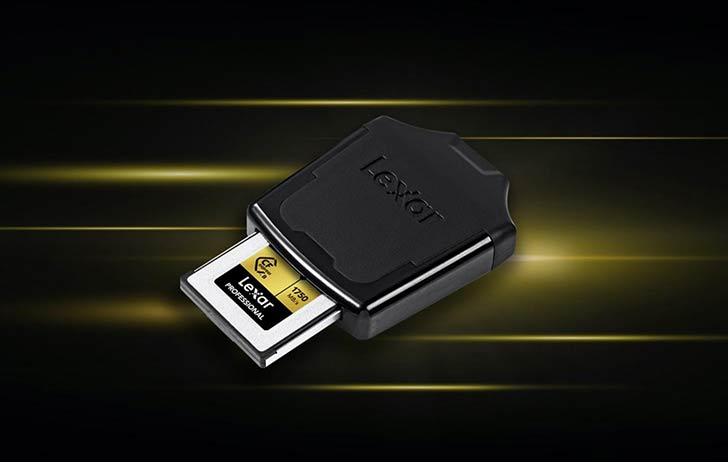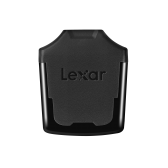San Jose, USA, June 2, 2020 – Today, Lexar, a leading global brand of flash memory solutions, announced the Lexar® Professional CFexpress™ USB 3.1 Reader. Geared towards making the workflow of professional photographers and videographers faster, this reader allows you to take advantage of the high-speed performance from the CFexpress Type B Card and offload your work, faster.
Key Features:
- Provides next-generation transfer speeds for high-quality images and RAW 4K video
- Designed for use with CFexpress™ Type B cards
- Transfer speeds of up to 1050MB/s1
- Leveraging USB 3.1 Gen 2 technology to dramatically accelerate workflow
- Includes a USB Type-C to USB Type-A cable
- Compact, portable design for photographers and videographers on the go
- Five-year limited warranty
With read speeds of up to 1050MB/s it’s easy to quickly transfer files on the go with the Lexar® Professional CFexpress™ USB 3.1 Reader. This professional-level reader easily offloads a large number of high-quality images and RAW 4K video from your CFexpress Type B card to your computer at USB 3.1 Gen 2 speeds, accelerating workflow and getting you back behind the camera faster. Sporting a compact and portable design capable of sliding into your pocket, it stands up in the field just as well as it does in the office. This reader is a perfect companion with the now available Lexar Professional CFexpress Type B card* that has large capacities from 64GB to 512GB.
“We are proud to announce the Lexar Professional CFexpress™ USB 3.1 Reader, designed for professional videographers and photographers to get the max performance out of their CFexpress Type B cards and to expedite transfers from card to computer,” said Joel Boquiren, Senior Director, Global Marketing.
The Lexar® Professional CFexpress Type B Card is also now available at Adorama and B&H at an MSRP of $199.99 USD (128GB), and $399.99 USD (256GB) with 64GB and 512GB to be released at a future date. It also comes with a lifetime limited warranty.
All Lexar product designs undergo extensive testing in the Lexar Quality Labs, facilities with more than 1,100 digital devices, to ensure performance, quality, compatibility, and reliability. For more information visit www.lexar.com




USB-C to USB-C will be faster than Wifi I would think. But even then there are CFE readers for under £300 on TB3(much faster than this, suggesting this should be quite cheep)
Lexar CFexpress USB 3.1 Reader
Happy to buy one later but there will be some big one-time costs to jump into RF for me.
Relying on wireless as your main connection will be painfully slow to unload a full card. Especially given that the R5 shoots 45MP stills.
I'm not familiar with CRAW/.CR3 which is likely to be on the R5. The 5DS/R RAW files were about 60Mb in size and if I understand correctly, the CR3 files will replace mRaw and sRAW but they are using a lossy compression algorithm.
Does anyone have experience if the differences between CR3 and CR2 is quality? it looks to be a ~40% file size difference which will add up if shooting 20fps @ 45 Mp :)
It's possible that some pre-order offers for the R5 will come with a CFExpress card and reader similar to what was offered when the 1Dx MarkIII was introduced.
IQ barely takes a hit, although for the most critical work where the file is pushed a lot it might make a difference. Also see https://www.the-digital-picture.com/Canon-Cameras/Canon-C-RAW-Image-File-Format.aspx and also https://fstoppers.com/education/sam...-good-canons-new-compressed-raw-format-477335
By the way, don't all raws produced by a more recent Canon camera have the .CR3 extension, no matter if it's a normal raw or a c-raw?
The extension is CR3 whether normal or c-raw just a tag in exif to tell you its RAW or CRAW
Compared the normal CR3 with 5D4 CR2 and the files size is roughly the same
I am suggesting plugging the camera directly into your computer with USB-C. On a Mac you can use Image Capture to pull out the RAW files at as fast as your camera can deliver them. When I first got my Nikon Z6 I did this and it was plenty fast for reading out the card. If you are using a CFE card USB-C from the camera or a reader will not have enough bandwidth but it'll still be quick enough until you get a TB3 reader. WiFi I would only use as I shoot so at the end of the shoot all the images have already trickled into my laptop or iPad.
Exactly, saying '.CR3' is meaningless in that regard. If you want to point out lossy compression, that's CRAW. Lossless compression is RAW.
It is absolutely no deal to drag and drop all your files from the card into a folder named with the date of the shooting by using MAC Finder/ Windows Explorer which gives you max transfer rates.
This done, you just import the files into Lightroom without data transfer.
-> More speed, no failures/ crashes since a decade, even with 20,000+ files within one import.
I've never just dumped my cards into Lightroom, you will quickly fill it with useless data that will slow it down. For my workflow I copy all of the images from the shoot to the client's project folder using Windows Explorer, I use FastStone to copy all of the technically correct images (exposure, focus, composition) to a new selections folder, then I use FastStone to batch process the RAWs into JPGs that I send to the customer. Once they make their picks only then do I import their picks into Lightroom.
With that workflow I can send clients proofs from say a wedding with 1500 images in less than an hour, and I only import images in Lightroom that will be processed. I've had Lightroom running for 5yrs on one install before and never needed a new database and it did not slow down from the original install (other than when Adobe screwed it up with patches but that's a different rant for a different day).
As far as Lexar goes, I'm slowly dumping all of their products; I've switched to SanDisk for all of my storage media and I'm not too impressed with their Lexar Workflow professional media hub. It is slow, I frequently have to remove and reinsert media before it is seen by the OS, and their CFast 2.0 module does not work at all, I ended up having to buy an Angelbird CFast reader to read my CFast cards.
In 2017 Lexar was bought out and their products have been circling the drain ever since: https://petapixel.com/2017/09/01/lexar-acquired-chinese-flash-storage-company/